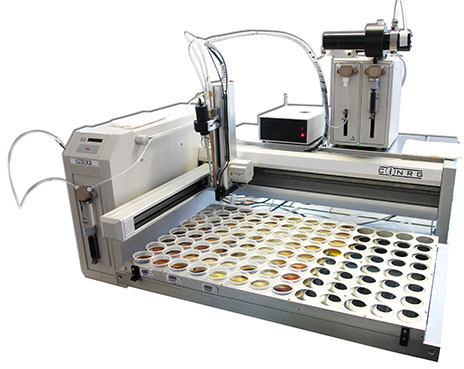
| OELCHECK test instrument: | Klotz particle counter with Gilson CINRG autosampler |
| Sample quantity: | approx. 20 ml |
| Unit: | number of particles per size per 100 ml |
| Test result: | cleanliness class according to ISO particle number according to size classes > 4µ, > 6µ, > 14µ |
| Analysis for: | hydraulic oils fluids with low viscosity (< ISO VG 150) |
| Brief description: | Before the actual counting, an innovative ultrasound sensor determines the exact size of the sample so that an exact solvent mixture of 75% toluene and 25% propanol at a ratio of 2:1 (based on ASTM D7647) can be used and this can be taken into account to determine a blind value. Immediately before the measurement, the sample is homogenised and degassed. Air bubbles escape quickly from the diluted sample and can therefore no longer be counted in the analysis. The effect of the propanol in the solvent mixture is that possible water droplets dissolve and become "invisible". In addition, the toluene dissolves any soft reaction products which may be present and ensures that only the hard particles which are actually present in the oil are counted with a laser sensor. The entire diluted sample of around 30 ml is then counted three times in a row, from which a mean average is extrapolated. If the individual values differ from each other greatly, the particle counter rejects the whole analysis and requests a new sample. |
| Statement: | Impurities in oil can always be a risk. Hard particles such as dust, coloured particles and wear metals can cause abrasive wear. Soft particles can build up from old additive components. Often they are adhesive too and cling to machine parts or filters, which they prevent from running smoothly. Particles in oil accelerate the ageing of oil and shorten its service life. Particularly when checking hydraulic, turbine and other low-viscosity oils, the pollution level is determined based on ISO 4406 by counting the size and number of particles in the laboratory with help from automatic particle counters (APC). The level of pollution is divided up into cleanliness classes. Here, laser sensors are used to determine the number and size of the particles. After the particles are counted, the oil is classified according to cleanliness. The processes used to determine oil cleanliness and cleanliness classes are defined under ISO 4406 and SAE 4059. ISO 4406 classification is based on particle sizes >4 µm, >6 µm and >14 µm. The ISO particle numbers are cumulative, which means that the stated particle figure for > 6 µm consists of all particles >6 µm plus particles >14 µm. |
| Underlying test standard: | ISO 4406, SAE AS 4059, ISO 11500, ASTM D7647 |